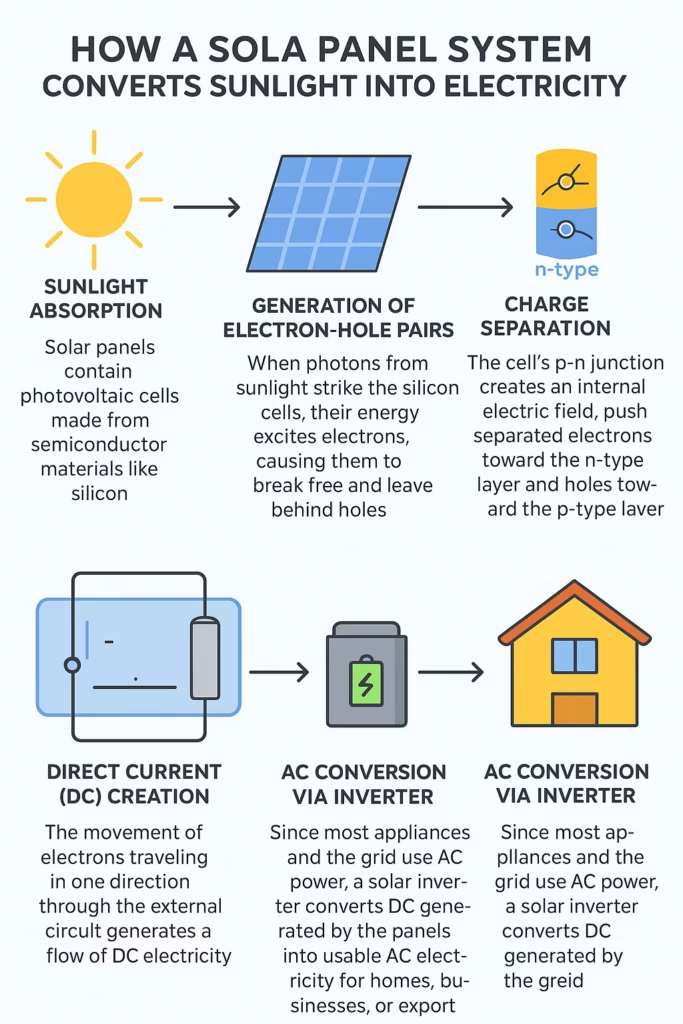Physical Address
Kurukshetra, Haryana (India)
For Any Query: Contact Us
Learn More About GyanFry
Solar energy is one of the cleanest and most abundant sources of power available today. But have you ever wondered how sunlight—something we see and feel but can’t touch—turns into electricity that powers our homes, gadgets, and even electric cars? The answer lies in the fascinating science of solar panel systems. Let’s break it down step by step in the simplest way possible.
The first step is simple: catch sunlight. A solar panel is made of many small photovoltaic (PV) cells, usually made from silicon, a semiconductor material. Think of each PV cell as a tiny solar battery that absorbs sunlight.
When sunlight hits these cells, the energy from the light is absorbed by the silicon atoms inside the cell. This is the start of the transformation from light to electricity.
Once sunlight is absorbed, something amazing happens at the microscopic level. Sunlight consists of photons, tiny particles of light. When photons hit the silicon atoms, they transfer their energy to electrons, giving them enough energy to break free from their normal positions.
This process creates electron-hole pairs, which are essential for generating electricity.
Simply freeing electrons is not enough—we need them to move in a specific direction to create electricity. This is where the p-n junction in the solar cell comes into play.
The junction between them creates an electric field. This field pushes electrons toward the n-type side and holes toward the p-type side, preventing them from recombining immediately.
Example: Think of a water slide. Electrons are like water being pushed down a slide in one direction. Without the slide, the water would just spill randomly; the slide guides it where you want.
This separation of charges is crucial—it ensures that the electrons flow through an external circuit rather than just recombining inside the cell.
Once electrons are pushed toward one side, they travel through wires connecting the solar cells. This movement of electrons in one direction is called Direct Current (DC) electricity.
Example: Picture a line of people passing a bucket of water down the line. The water moves in only one direction—this is like electrons moving to produce DC electricity.
This DC electricity is what the solar panels generate naturally.
Most of our homes and appliances, and the electricity grid, use Alternating Current (AC), not DC. That’s where a solar inverter comes in. The inverter takes the DC electricity from the solar panels and converts it into AC electricity, which can then:
Example: Think of DC as water flowing through a garden hose in one direction. But your home’s plumbing sometimes needs water moving back and forth to operate certain devices. The inverter is like a special pump that changes the flow to the right type.
Not all sunlight is converted into electricity. Only the photons absorbed by the solar cell matter, and the internal electric field ensures efficient charge separation. The efficiency of solar panels varies:
This means that for every 100 units of sunlight hitting a high-quality panel, about 22 units are converted into electricity.
Example: Imagine you collect 100 apples from a tree, but only 22 are ripe enough to eat. That’s the panel’s efficiency.
The rest of the energy might be lost as heat or reflected away.

In simple terms, a solar panel system works like this:
Thanks to this combination of semiconductor physics and smart electronics, sunlight—a renewable and clean energy source—is transformed into reliable electricity.
Solar panels are not magic—they are a smart application of physics. By capturing photons, separating charges, and guiding electron flow, they convert sunlight into electricity efficiently. With improvements in technology, more sunlight can be harnessed, making solar energy a cornerstone of sustainable living.